News
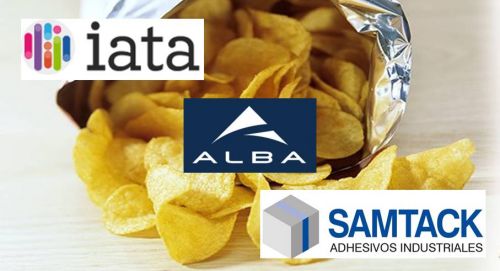
02/11/2018
Food packaging? ALBA!
Food packaging? ALBA!
Two recent experiments carried out at the ALBA synchrotron once again remind us how ALBA can be useful for developing new products, in this case in the food packaging sector.
On one hand, researchers from the Food Safety and Preservation department of the Institute of Agrochemistry and Food Technology (IATA-CSIC) are looking for more sustainable ways of producing food packaging with appropriate mechanical and chemical properties. They are investigating biopolymers that can be made from biomass such as algae.
They have analysed how adding different microalgae species can modify the properties of starch-based biopolymers. During the process, they have been performing SAXS/WAXS experiments at the refurbished NCD-SWEET beamline of the ALBA Synchrotron, devoted to non-crystalline diffraction. Results show that Spirulina microalgae is a promising alternative for replacing part of the corn starch matrix of biopolymers.
Furthermore, Samtack is a manufacturer of glues and adhesives specialized in the sector of graphic arts and packaging. Samtack has developed a new flexible multilayer system, in collaboration with the University of Zaragoza and the Complutense University of Madrid, that contains Selenium nanoparticles and is capable to increase food shelf life by absorbing free radicals.
The samples studied at ALBA consisted of different preparations of Selenium nanoparticles plastics laminates and solutions to check the amount of elemental selenium and other selenium oxidation states in each sample. The results obtained provided to Samtack very valuable information to improve the synthesis of the new flexible multilayer system.
It should be noted that Samtack used ALBA thanks to the CALIPSOplus European project that helps SMEs access European light sources. In this regard, a CALIPSOplus call is open until December 21 to request financing support.
Learn more about these two experiments: here and here
On one hand, researchers from the Food Safety and Preservation department of the Institute of Agrochemistry and Food Technology (IATA-CSIC) are looking for more sustainable ways of producing food packaging with appropriate mechanical and chemical properties. They are investigating biopolymers that can be made from biomass such as algae.
They have analysed how adding different microalgae species can modify the properties of starch-based biopolymers. During the process, they have been performing SAXS/WAXS experiments at the refurbished NCD-SWEET beamline of the ALBA Synchrotron, devoted to non-crystalline diffraction. Results show that Spirulina microalgae is a promising alternative for replacing part of the corn starch matrix of biopolymers.
Furthermore, Samtack is a manufacturer of glues and adhesives specialized in the sector of graphic arts and packaging. Samtack has developed a new flexible multilayer system, in collaboration with the University of Zaragoza and the Complutense University of Madrid, that contains Selenium nanoparticles and is capable to increase food shelf life by absorbing free radicals.
The samples studied at ALBA consisted of different preparations of Selenium nanoparticles plastics laminates and solutions to check the amount of elemental selenium and other selenium oxidation states in each sample. The results obtained provided to Samtack very valuable information to improve the synthesis of the new flexible multilayer system.
It should be noted that Samtack used ALBA thanks to the CALIPSOplus European project that helps SMEs access European light sources. In this regard, a CALIPSOplus call is open until December 21 to request financing support.
Learn more about these two experiments: here and here
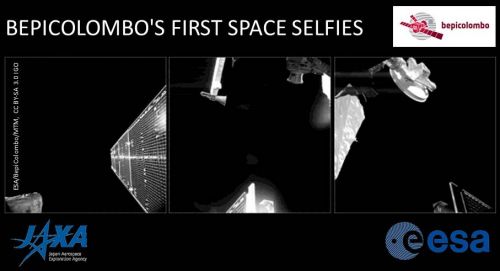
25/10/2018
SENER: on the way to Mercury!
SENER: on the way to Mercury!
BepiColombo module, composed of two satellites developed by the European Space Agency and its Japanese counterpart, respectively, took off from Kourou (French Guiana) on last October 19 to initiate its journey towards Mercury, a planet little explored and still very mysterious.
In this project, the SENER group companies with Catalan headquarters in the Barcelona Synchrotron Park are responsible for the low-gain antennas, the medium-gain antenna and the waveguides for routing the signal and the pointing mechanism for the high-gain antenna. These units are responsible for staying in contact with the Earth at all times by transmitting the satellite's telemetry and receiving its telecommands, as well as sending all the scientific data. SENER also manufactured the magnetometer boom, which separates the instruments from the satellite's magnetic influence. All these instruments are thus a critical element to the success of the mission.
BepiColombo launch is just the beginning of a 7-year very long trip (8.5 billion kilometers): Although Mercury, the nearest planet from the Sun, is relatively closed (the shortest Earth-Mercury distance is 80 million kilometers), the giant mass of the Sun does not allow a straight trip: if so, BepiColombo could not be decelerated and would inexorably fall into our star.
The technological challenge imposed by the proximity of the Sun is huge. For instance, some materials will have to resist to both extremely low (-170ºC) and high (450ºC) temperatures.
When BepiColombo arrives close to Mercury in December 2025, both scientific modules (MPO for Europe and Mio from Japan) will split up and begin their respective mission on two different orbits around the planet. MPO (11 instruments) will investigate the surface and the composition of Mercury and Mio (5 instruments) will focus on the environment (magnetosphere, atmosphere, dust, solar wind).
To follow the mission: here
Have a nice trip! See you there!
In this project, the SENER group companies with Catalan headquarters in the Barcelona Synchrotron Park are responsible for the low-gain antennas, the medium-gain antenna and the waveguides for routing the signal and the pointing mechanism for the high-gain antenna. These units are responsible for staying in contact with the Earth at all times by transmitting the satellite's telemetry and receiving its telecommands, as well as sending all the scientific data. SENER also manufactured the magnetometer boom, which separates the instruments from the satellite's magnetic influence. All these instruments are thus a critical element to the success of the mission.
BepiColombo launch is just the beginning of a 7-year very long trip (8.5 billion kilometers): Although Mercury, the nearest planet from the Sun, is relatively closed (the shortest Earth-Mercury distance is 80 million kilometers), the giant mass of the Sun does not allow a straight trip: if so, BepiColombo could not be decelerated and would inexorably fall into our star.
The technological challenge imposed by the proximity of the Sun is huge. For instance, some materials will have to resist to both extremely low (-170ºC) and high (450ºC) temperatures.
When BepiColombo arrives close to Mercury in December 2025, both scientific modules (MPO for Europe and Mio from Japan) will split up and begin their respective mission on two different orbits around the planet. MPO (11 instruments) will investigate the surface and the composition of Mercury and Mio (5 instruments) will focus on the environment (magnetosphere, atmosphere, dust, solar wind).
To follow the mission: here
Have a nice trip! See you there!
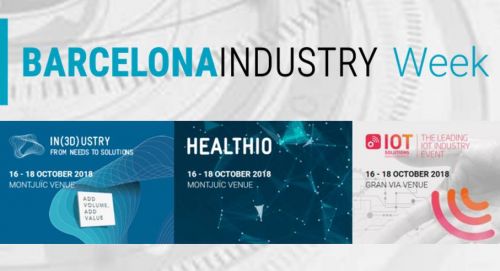
18/10/2018
The Barcelona Industry Week promotes the (4.0) revolution
The Barcelona Industry Week promotes the (4.0) revolution
The so-called 4.0 industrial revolution seems unstoppable and forces companies to operate their digital transformations.
The Barcelona Industry Week held this week, is dedicated to the 4.0 industry and plans to attract 21,000 professional visitors in its second edition. This event wants to provide answers to this new economic and social reality with the aim of helping the industrial and productive fabric to meet these new challenges.
IoT, Artificial Intelligence, Blockchain, Robotics or 3D are just some of the technologies that are already transforming the industry and that will be addressed by the Barcelona Industry Week. This international event is made up of three fairs: In(3D)dustry From Need To Solutions, focused on 3D printing and advanced manufacturing, the IoT Solutions World Congress, focused on the Internet of Things, and Healthio, newly created, focussed on innovations in the health sector.
To bits, businessmen!
The Barcelona Industry Week held this week, is dedicated to the 4.0 industry and plans to attract 21,000 professional visitors in its second edition. This event wants to provide answers to this new economic and social reality with the aim of helping the industrial and productive fabric to meet these new challenges.
IoT, Artificial Intelligence, Blockchain, Robotics or 3D are just some of the technologies that are already transforming the industry and that will be addressed by the Barcelona Industry Week. This international event is made up of three fairs: In(3D)dustry From Need To Solutions, focused on 3D printing and advanced manufacturing, the IoT Solutions World Congress, focused on the Internet of Things, and Healthio, newly created, focussed on innovations in the health sector.
To bits, businessmen!
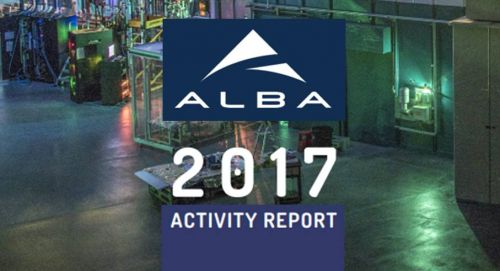
11/10/2018
Everything you’ve always wanted to know about Alba synchrotron
Everything you’ve always wanted to know about Alba synchrotron
The ALBA Synchrotron has published its annual report. This document covers the most remarkable activities of 2017, a selection of scientific highlights, technology reviews and facts & figures of the facility last year.
At page 8, we read:
“Alba in brief:
• User operations started in 2012 • 3 GeV 150 mA Top-Up operations with a current variation lower than 1% • 5900h of operation with 4650h user time - 98% availability • 21 M€ operation budget in 2017 • Proposals have increased from about 200 in 2012 to almost 400 in 2017. Average overboooking factor: 2 • User affiliation: 65% national, 30% European, 5% non-European • Eight beamlines in operation, three under construction, one under design and three pending approval”
To learn more about Alba: 110 other pages available here.
At page 8, we read:
“Alba in brief:
• User operations started in 2012 • 3 GeV 150 mA Top-Up operations with a current variation lower than 1% • 5900h of operation with 4650h user time - 98% availability • 21 M€ operation budget in 2017 • Proposals have increased from about 200 in 2012 to almost 400 in 2017. Average overboooking factor: 2 • User affiliation: 65% national, 30% European, 5% non-European • Eight beamlines in operation, three under construction, one under design and three pending approval”
To learn more about Alba: 110 other pages available here.

04/10/2018
Parks: the importance of infrastructures
Parks: the importance of infrastructures
During the Rebuild Expo and Congress held last week in Barcelona on innovation in the building sector, we had the opportunity to attend a round table about “Remaking industrial spaces”.
Industrial areas or business parks, whatever the name given, concentrate companies close to cities. One key factor that makes them attractive and provides companies of a given territory with the right tools to make them competitive is the quality of their infrastructures. Regarding this issue, different speakers pointed out the too large proportion of old and outdated business parks.
These considerations lead us to remind the high quality of the infrastructures offered by the Barcelona Synchrotron Park.
Let’s point out 4 of them:
Industrial areas or business parks, whatever the name given, concentrate companies close to cities. One key factor that makes them attractive and provides companies of a given territory with the right tools to make them competitive is the quality of their infrastructures. Regarding this issue, different speakers pointed out the too large proportion of old and outdated business parks.
These considerations lead us to remind the high quality of the infrastructures offered by the Barcelona Synchrotron Park.
Let’s point out 4 of them:
- High capacity and reliability power network, including an own electric station.
- A polygeneration plant and its district heating and cooling system that feeds all plots in the park and offers companies: reduction of initial investment and less physical space to allocate to bulky equipment, reduction of some 20% of associated operating and maintenance costs, flexibility if energy requirements change.
- 7 telecom operators in the park with their own infrastructure: British Telecom, Telefónica, Orange, Colt, ONO, Ufinet, XOC.
- 3 Data Centers that give companies the possibility to save their data in a close cloud, an option increasingly valued.
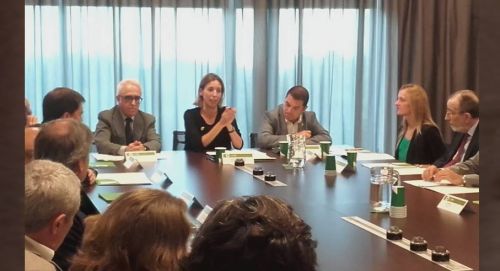
27/09/2018
Catalan Minister of Business and Knowledge visits the park
Catalan Minister of Business and Knowledge visits the park
On last September 14, Catalan Minister of Business and Knowledge, Ms. Àngels Chacón, paid a visit to the Barcelona Synchrotron Park in order to discover first-hand the reality of the park, its growth dynamics and its role as an economic driver of the territory.
Park’s director Pere Solà presented the different companies already installed or about to arrive (iconic Alba synchrotron included), park’s commitment to protecting biodiversity and its singular infrastructures including a district cooling and heating network, 7 telecoms operators and different data centres.
During the discussion with the representatives of the different park’s companies, one of the topics was the need to get at a global level well prepared professionals able to match companies’ necessities. This includes for instance improving professional training.
Before going for a walk in the park, the minister informed the attendees of the new government’s projects regarding industry and research policies: this includes, among other aspects, the deployment of the National pact for industry in order to make productive sectors more innovating and globalized and the elaboration of a Catalan Science law.
Park’s director Pere Solà presented the different companies already installed or about to arrive (iconic Alba synchrotron included), park’s commitment to protecting biodiversity and its singular infrastructures including a district cooling and heating network, 7 telecoms operators and different data centres.
During the discussion with the representatives of the different park’s companies, one of the topics was the need to get at a global level well prepared professionals able to match companies’ necessities. This includes for instance improving professional training.
Before going for a walk in the park, the minister informed the attendees of the new government’s projects regarding industry and research policies: this includes, among other aspects, the deployment of the National pact for industry in order to make productive sectors more innovating and globalized and the elaboration of a Catalan Science law.









